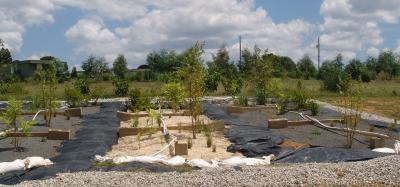
Rain gardens, shown in the photo at planting time, were used to determine the effectiveness of three filter bed substrates. Twelve rain gardens containing 16 plant species were evaluated in the North Carolina study. Credit: Photo courtesy of Helen Kraus.
Bioretention is one of the most popular green infrastructure practices in many areas throughout the U.S. That is evident in the Chesapeake Stormwater Network’s recently released survey of stormwater management practices in the Chesapeake Bay Watershed, where bioretention was the most implemented practice over the last year. In fact, bioretention was implemented almost twice as often as the next most common option, disconnecting impervious surfaces. The Chesapeake Stormwater Network conducts these annual surveys, and also points out several trends including an increase in implementation of high-performing practices over conventional stormwater controls. Additionally, the organization noted that low impact development is being implemented on smaller drainage areas, often less than an acre in size.
Despite its growing use, there are still research questions surrounding bioretention, and two new studies announced this summer evaluate the practice’s performance and performance factors. Toronto and Region Conservation recently released the results of a study initiated in 2010 evaluating a bioretention cell draining a 2061 m2 (22,184 ft2) parking lot. The cell was monitored and evaluated under the Sustainable Technologies Evaluation Program. The performance of the system was tested in terms of water quality as well as hydrologic performance and ability to mimic pre-development conditions seasonally and over the life of the system. Researchers also assessed maintenance needs and activities.
Researchers from North Carolina State University designed experiments to assess three different bioretention filter bed substrates for their effectiveness in nutrient removal and supporting plant growth. “The filter bed substrate is the foundation of the rain garden and gives it the ability to infiltrate runoff, slow drainage, support plant growth, and remove pollutants,” explained Helen Kraus, lead author of a study published May 2014 in HortScience.
The research team constructed 12 rain gardens filled with one of three filter bed substrates. The gardens were planted with 16 diverse plant species, and then irrigated with stormwater. The substrates used in the experiments included a sand-based substrate composed of 80% washed sand, 15% clay and silt fines, and 5% pine bark; a soil-based substrate composed of 50% sandy loam soil and 50% pine bark; and a slate-based substrate composed of 80% expanded slate and 20% pine bark. The substrates differed in infiltration and drainage rates as well as chemical composition.
Results showed that sand had good overall retention of pollutants except nitrogen. Soil had the lowest remediation of phosphorus and highest concentration of phosphorus in its effluent, and was similar in nitrogen removal efficiency to slate. Slate had the best retention of nitrogen and phosphorus. “Overall, all three substrates functioned in reducing the quantity of pollutants in urban stormwater runoff,” the authors noted. They added that the impact of substrate on remediation appeared to lessen by the second season of the study; as the plants grew, root growth impacted infiltration, and nutrient uptake by the plants increased.




